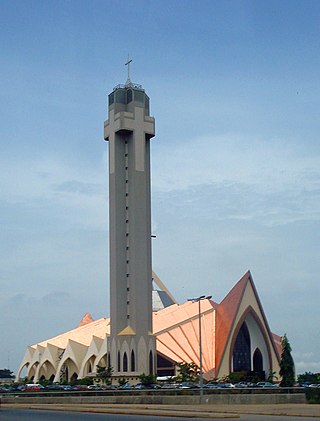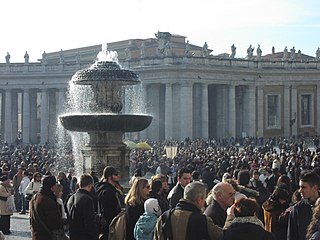
The Second Great Awakening was a Protestant religious revival during the late 18th to early 19th century in the United States. It spread religion through revivals and emotional preaching and sparked a number of reform movements. Revivals were a key part of the movement and attracted hundreds of converts to new Protestant denominations. The Methodist Church used circuit riders to reach people in frontier locations.
In religious organizations, the laity consists of all members who are not part of the clergy, usually including any non-ordained members of religious orders, e.g. a nun or a lay brother. In both religious and wider secular usage, a layperson is a person who is not qualified in a given profession or does not have specific knowledge of a certain subject. The phrase "layman's terms" is used to refer to plain language that is understandable to the everyday person, as opposed to specialised terminology understood only by a professional.
A parochial school is a private primary or secondary school affiliated with a religious organization, and whose curriculum includes general religious education in addition to secular subjects, such as science, mathematics and language arts. The word parochial comes from the same root as "parish", and parochial schools were originally the educational wing of the local parish church. Christian parochial schools are called "church schools" or "Christian schools."

Religion in the United States began with the religions and spiritual practices of Native Americans. Later, religion also played a role in the founding of some colonies, as many colonists, such as the Puritans, came to escape religious persecution. Historians debate how much influence religion, specifically Christianity and more specifically Protestantism, had on the American Revolution. Many of the Founding Fathers were active in a local Protestant church; some of them had deist sentiments, such as Thomas Jefferson, Benjamin Franklin, and George Washington. Some researchers and authors have referred to the United States as a "Protestant nation" or "founded on Protestant principles," specifically emphasizing its Calvinist heritage. Others stress the secular character of the American Revolution and note the secular character of the nation's founding documents.
The Social Gospel is a social movement within Protestantism that aims to apply Christian ethics to social problems, especially issues of social justice such as economic inequality, poverty, alcoholism, crime, racial tensions, slums, unclean environment, child labor, lack of unionization, poor schools, and the dangers of war. It was most prominent in the early 20th-century United States and Canada. Theologically, advocates of the movement sought to put into practice the Lord's Prayer : "Thy kingdom come, Thy will be done on earth as it is in heaven". They typically were postmillennialist; that is, they believed the Second Coming could not happen until humankind rid itself of social evils by human effort. The Social Gospel was more popular among clergy than laity. Its leaders were predominantly associated with the liberal wing of the progressive movement and most were theologically liberal, although a few were also conservative when it came to their views on social issues. Important leaders included Richard T. Ely, Josiah Strong, Washington Gladden, and Walter Rauschenbusch.

The Apostolic Movement of Schoenstatt is a Catholic Marian movement founded in Germany in 1914 by Fr Joseph Kentenich, who saw the movement as a means of spiritual renewal for the Catholic Church. The movement is named after the small locality of Schönstatt which is part of the town of Vallendar near Koblenz, in Germany.

The phrase Catholic youth work covers a wide range of activities carried out with young people, usually in the name of the Catholic Church and with the intention of imparting the Catholic faith to them and inviting them to practice and live out the faith in their lives. Activities in the field range from small scale youth groups attached to parishes or Catholic schools, to large international gatherings, such as World Youth Day. It is a field which has evolved much over recent decades, especially in comparison to more formal methods of education or catechesis within the church. Nearly all dioceses and a great deal of parishes have some form of youth provision running, although a great deal of areas particularly in the developed world are finding youth work both more difficult and rare as the numbers of young people regularly practicing the Catholic faith continue to decline. In contrast, though, the new and exciting developments of recent decades and particularly the influence of the new movements within the Church are ensuring that youth work continues to be an active and fruitful field.

Christianity and Islam are the two main religions practiced in Nigeria. The country is home to some of the world's largest Christian and Muslim populations, simultaneously. Reliable recent statistics do not exist; however, Nigeria is divided roughly in half between Muslims, who live mostly in the northern region, and Christians, who live mostly in the southern region of the country. Indigenous religions, such as those native to the Igbo and Yoruba ethnicities, have been declining for decades and being replaced by Christianity or Islam. The Christian share of Nigeria's population is also now on the decline, due to a lower fertility rate relative to the Muslim population in the country.
Catholic Action is a movement of lay people within the Catholic Church which advocates for increased Catholic influence on society. Catholic Action groups were especially active in the nineteenth century in historically Catholic countries under anti-clerical regimes, such as Spain, Italy, Bavaria, France, and Belgium.
An ecclesial base community is a relatively autonomous Christian religious group that operates according to a particular model of community, worship, and Bible study. The 1968 Medellín, Colombia, meeting of Latin American Council of Bishops played a major role in popularizing them under the name basic ecclesial communities. These are small groups, originating in the Catholic Church in Latin America, who meet to reflect upon scripture and apply its lessons to their situation.

Religion of Black Americans refers to the religious and spiritual practices of African Americans. Historians generally agree that the religious life of Black Americans "forms the foundation of their community life". Before 1775 there was scattered evidence of organized religion among Black people in the Thirteen Colonies. The Methodist and Baptist churches became much more active in the 1780s. Their growth was quite rapid for the next 150 years, until their membership included the majority of Black Americans.

The Catholic Women's League (CWL) is a Catholic lay organisation founded in 1906 by Margaret Fletcher. Originally intended to bring together Catholic women in England, the organization has grown, and may be found in numerous Commonwealth countries. It is especially flourishing in Canada, Australia, New Zealand and Hong Kong. Membership consists mainly of women who are members of the Catholic Church, and who work together to promote Catholic values and to carry out volunteer and charitable work.

Vocational discernment is the process by which men and women in the Catholic Church discern, or recognize, their vocation in the church and the world. The vocations are the life of a layperson in the world, either married or single, the ordained life of bishops, priests, and deacons, and consecrated religious life.

Emerging since the 19th century, there are several Protestant adherent and groups, sometimes organised as religious orders, which strive to adhere to the teachings and spiritual disciplines of Saint Francis of Assisi.
Christian revivalism is increased spiritual interest or renewal in the life of a Christian church, congregation or society with a local, national or global effect. This should be distinguished from the use of the term "revival" to refer to an evangelistic meeting or series of meetings. Proponents view revivals as the restoration of the church to a vital and fervent relationship with God after a period of moral decline.

Catholic laity are the ordinary members of the Catholic Church who are neither clergy nor recipients of Holy Orders or vowed to life in a religious order or congregation. Their mission, according to the Second Vatican Council, is to "sanctify the world".
Catholic sisters and nuns in the United States have played a major role in American religion, education, nursing and social work since the early 19th century. In Catholic Europe, convents were heavily endowed over the centuries, and were sponsored by the aristocracy. Religious orders were founded by entrepreneurial women who saw a need and an opportunity, and were staffed by devout women from poor families. The number of Catholic nuns grew exponentially from about 900 in the year 1840, to a maximum of nearly 200,000 in 1965, falling to 56,000 in 2010. According to an article posted on CatholicPhilly.com, the website of the Archdiocese of Philadelphia, Pennsylvania, in October 2018, National Religious Retirement Office statistics showed that number as 47,160 in 2016, adding that “about 77 percent of women religious are older than 70.” In March 2022, the NRRO was reporting statistics from 2018, citing the number of professed sisters as 45,100. The network of Catholic institutions provided high status lifetime careers as nuns in parochial schools, hospitals, and orphanages. They were part of an international Catholic network, with considerable movement back and forth from Britain, France, Germany and Canada.
Janet Kalven was a Catholic educator and writer associated with the Grail, a women's religious movement founded in 1921.

Elizabeth Julia Reid was an Australian journalist and a lay leader in the Grail movement for Catholic woman.











